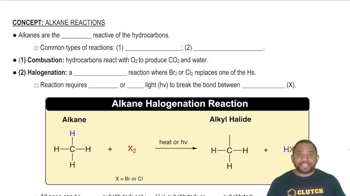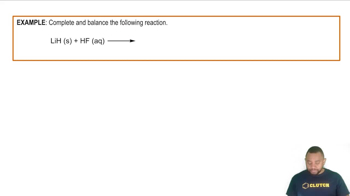Write a balanced equation for the reaction that occurs in each of the following cases: (a) White phorphrous, P4(s), reacts with chlorine gas. (b) Sodium metal reacts with water. (c) Sulfur reacts with hydrogen gas.
Ch.7 - Periodic Properties of the Elements
Chapter 7, Problem 78
Write a balanced equation for the reaction that occurs in each of the following cases: (a) Calcium metal is heated in an atmosphere of oxygen gas. (b) Copper oxide is heated in an atmosphere of hydrogen gas. (c) Chlorine reacts with nitrogen gas. (d) Boron tribromide reacts with water.
 Verified step by step guidance
Verified step by step guidance1
Step 1: Identify the reactants and products for each reaction. For (a), the reactants are calcium (Ca) and oxygen gas (O2), and the product is calcium oxide (CaO). For (b), the reactants are copper oxide (CuO) and hydrogen gas (H2), and the products are copper (Cu) and water (H2O). For (c), the reactants are chlorine (Cl2) and nitrogen gas (N2), and the product is nitrogen trichloride (NCl3). For (d), the reactants are boron tribromide (BBr3) and water (H2O), and the products are boric acid (H3BO3) and hydrogen bromide (HBr).
Step 2: Write the unbalanced chemical equations for each reaction. (a) Ca + O2 -> CaO, (b) CuO + H2 -> Cu + H2O, (c) Cl2 + N2 -> NCl3, (d) BBr3 + H2O -> H3BO3 + HBr.
Step 3: Balance the chemical equation for reaction (a). Ensure that the number of atoms of each element is the same on both sides of the equation. For example, balance the oxygen atoms first, then the calcium atoms.
Step 4: Balance the chemical equation for reaction (b). Start by balancing the copper atoms, then balance the oxygen and hydrogen atoms.
Step 5: Balance the chemical equations for reactions (c) and (d). For (c), balance the nitrogen atoms first, then the chlorine atoms. For (d), balance the boron atoms, then the hydrogen and bromine atoms.
Key Concepts
Here are the essential concepts you must grasp in order to answer the question correctly.
Balancing Chemical Equations
Balancing chemical equations involves ensuring that the number of atoms of each element is the same on both sides of the equation. This is based on the law of conservation of mass, which states that matter cannot be created or destroyed in a chemical reaction. To balance an equation, coefficients are adjusted in front of the chemical formulas to achieve equal atom counts.
Recommended video:
Guided course

Balancing Chemical Equations
Types of Chemical Reactions
Understanding the types of chemical reactions is crucial for predicting products and writing balanced equations. Common types include synthesis (combination), decomposition, single replacement, and double replacement reactions. Each type has characteristic patterns that can guide the formulation of products when reactants are combined.
Recommended video:
Guided course

Common Types of Alkane Reactions
Reactants and Products
In a chemical reaction, reactants are the starting substances that undergo change, while products are the substances formed as a result of the reaction. Identifying the correct reactants and predicting the products is essential for writing balanced equations. Knowledge of the properties and reactivity of elements and compounds helps in determining the expected outcomes of reactions.
Recommended video:
Guided course

Production of Hydrogen Example
Related Practice
Textbook Question
1
views
Textbook Question
Write a balanced equation for the reaction that occurs in each of the following cases: (d) Fluorine reacts with water.
1
views
Textbook Question
Consider the stable elements through lead (Z = 82). In how many instances are the atomic weights of the elements out of order relative to the atomic numbers of the elements?
Textbook Question
Figure 7.4 shows the radial probability distribution functions for the 2s orbitals and 2p orbitals. (a) Which orbital, 2s or 2p, has more electron density close to the nucleus?
Textbook Question
Figure 7.4 shows the radial probability distribution functions for the 2s orbitals and 2p orbitals. (b) How would you modify Slater's rules to adjust for the difference in electronic penetration of the nucleus for the 2s and 2p orbitals?
